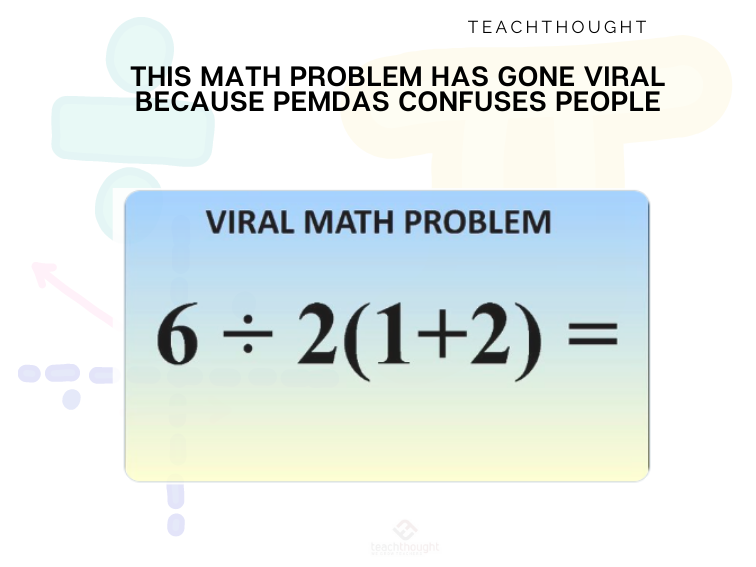
Because PEMDAS Confuses People, This Math Problem Has Gone Viral
by TeachThought Staff
It seems like every few weeks, a math problem gets passed around that starts an argument and goes viral because no one can agree on the answer. And it almost always involves PEMDAS.
Why is PEMDAS so confusing? It has to do with math-as-a-kind-of-language. Wikipedia explains PEMDAS:
“In mathematics and computer programming, the order of operations (or operator precedence) is a collection of rules that reflect conventions about which procedures to perform first in order to evaluate a given mathematical expression.
For example, in mathematics and most computer languages, multiplication is granted a higher precedence than addition, and it has been this way since the introduction of modern algebraic notation.Thus, the expression 2 + 3 × 4 is interpreted to have the value 2 + (3 × 4) = 14, and not (2 + 3) × 4 = 20. With the introduction of exponents in the 16th and 17th centuries, they were given precedence over both addition and multiplication and could be placed only as a superscript to the right of their base. Thus 3 + 52 = 28 and 3 × 52 = 75.
These conventions exist to eliminate notational ambiguity while allowing notation to be as brief as possible. Where it is desired to override the precedence conventions, or even simply to emphasize them, parentheses ( ) can be used to indicate an alternative order of operations (or to simply reinforce the default order of operations). For example, (2 + 3) × 4 = 20 forces addition to precede multiplication, while (3 + 5)2 = 64 forces addition to precede exponentiation. If multiple pairs of parentheses are required in a mathematical expression (such as in the case of nested parentheses), the parentheses may be replaced by brackets or braces to avoid confusion, as in [2 × (3 + 4)] − 5 = 9.”
See also 12 Questions To Help Students See Themselves As Thinkers
This Math Problem Has Gone Viral Because PEMDAS Confuses People
So what’s the problem? For one, twitter and the nature of disinformation and disagreement and the kind of content that is more likely to be shared. Here’s the latest example making the rounds.
Social media was created for sharing and disagreement, so here we are. As we mentioned, these go viral often and in 2019, University of Kentucky math Ph.D. Jared Antrobus explained why everyone is getting this all wrong in, ‘The Failure of PEMDAS.’
In the post, he explains that the problem can’t really be solved as stated because it’s ambiguous.
“The issue with this problem is that division is not associative. If we were asked to evaluate 12 ÷ 6 ÷ 3, we would have a very similar issue. Which division sign do we do first? Regardless of what our elementary school teacher told us, we can’t assume that the problem’s author intended us to work from left to right. In fact, different calculators will give different answers, depending on how they’re programmed!
How do we deal with nonassociative operations?
The only reason that we can forgo writing parentheses with long strings of addition and multiplication is because of their associativity. For division, we must specify which operation to do first. We should either write (12 ÷ 6) ÷ 3 or 12 ÷ (6÷3) so that the reader knows exactly what we mean.
The expression 12 ÷ 6 ÷ 3 is ambiguous. It could mean two different things. The only way we can know which was intended by the author is to ask for clarification. The same goes for 6 ÷ 2 × 3.”
Ambiguity makes answering questions impossible!
Ambiguous statements are not exclusive to mathematics. The following question is similarly upsetting:
If a woman plays her sister at chess and she’s a grandmaster, is she likely to win?
Once again, the author’s intent is unclear. Which woman does each instance of “she” refer to? The only way to know is to ask for clarification.”
Conclusion
We just thought the math teachers out there might find it a nice break from the nearly non-stop bad-news-cycle that has been 2020. It likely won’t be trending by the time you read this, but there it is nonetheless. See for yourself.
